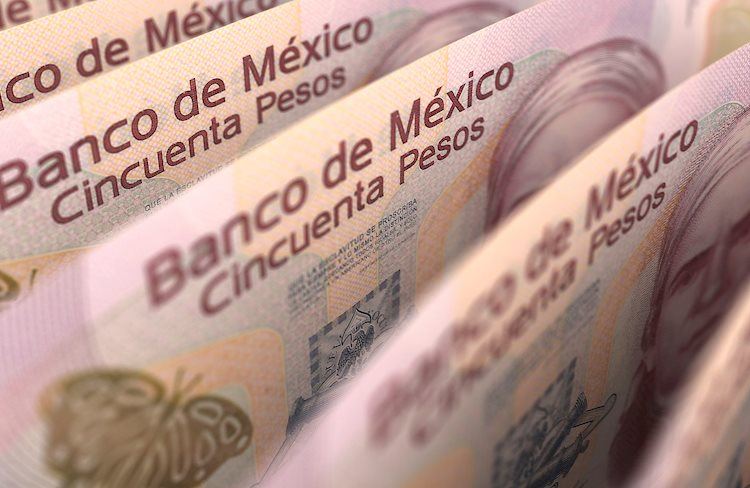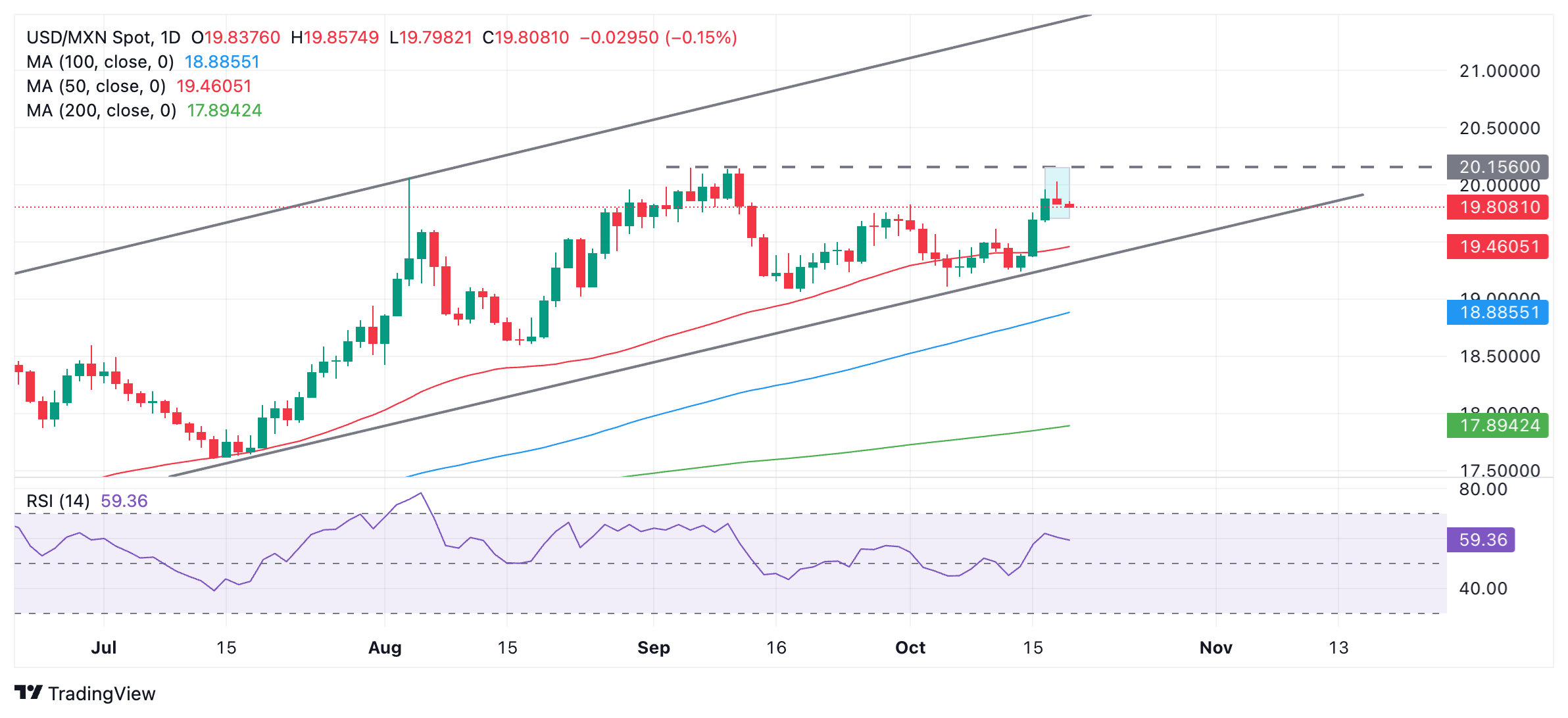- The Mexican Peso halts its march lower after strong economic data from the US, its largest trading partner.
- China data tempers slowdown fears and also supports emerging market FX, including the MXN.
- USD/MXN stalls, forms a Shooting Star candlestick pattern and reverses.
The Mexican Peso (MXN) trades marginally higher in its most heavily-traded pairs on Friday after bottoming out of its three-day down slope on Thursday.
A blend of not-as-bad-as-expected China growth data and strong US Retail Sales and Jobless Claims released on Thursday are helping bulls turn the Peso tanker slowly around. The Chinese data lifts market sentiment, providing a gentle backdraught to stern for MXN, whilst the strong US data supports the Peso because of the importance of the US market for Mexican exports.
That said, Peso-negative factors are likely to continue to provide a headwind. These include threats from former president Donald Trump to slam up to 300% tariffs on Mexican car imports, the widespread view that Mexico is facing an economic slowdown – given credence by a recent International Monetary Fund (IMF) report – political risk from constitutional reforms the market doesn’t like, and persistent concerns around the budget deficit.
Mexican Peso recovers after US, China data
The Mexican Peso found support on Thursday and managed to end its string of losing days after strong data out of the US painted an improved economic outlook for its most significant trading partner.
US Retail Sales and Retail Sales ex Autos both showed a higher-than-expected rise in September, and were above the increases seen in August. Retail Sales rose 0.4% and sales ex autos by 0.5%, beating estimates of 0.3% and 0.1%, respectively, and previous readings of 0.1% and 0.2% (revised up).
Initial Jobless Claims also indicated a resilient labor market with 241K out-of-work Americans claiming benefits in the week ending October 11. This was below the 260K expected and 260K (revised up) in the previous week. Given the Federal Reserve’s concerns about the fragility of the US labor market, the data had a disproportionately positive impact on the outlook for the economy as well as the future path of monetary policy, two key elements driving currencies.
“The main catalyst for the day’s market moves was another batch of upbeat US data, which dampened any immediate fears about a potential recession,” said Jim Ried, Global Head of Macro Research at Deutsche Bank. “It feels a far cry from the recession fears of the summer, and also from the 260bps of Fed cuts priced in by the end of 2025 shortly before the September FOMC,” added Reid.
China data lessens concerns over slowdown
The Mexican Peso might have gained further support on Friday morning after the release of China Gross Domestic Product (GDP) growth, Retail Sales and Industrial Production data, which came out overall on the positive side, and helped to boost global market sentiment, which, in turn, tends to be positive for the Peso.
Chinese GDP increased by a higher-than-expected 4.6% YoY in Q3, which whilst below Q2’s 4.7% was not as bad as the 4.5% growth forecast by economists.
On a QoQ basis, GDP grew 0.9% in Q3, which though below the 1.0% forecast was, nevertheless, above the 0.7% expansion seen in Q2.
China Retail Sales surged 3.2% YoY in September, from 2.1% in the previous month and trouncing expectations of 2.5%. It was a similar story with Industrial Production, which rose 5.2% YoY in September, beating both previous (4.5%) and expected readings (4.6%).
Technical Analysis: USD/MXN recovery stalls and forms Shooting Star candlestick
USD/MXN stalls mid-takeoff, rolling over after three green up days and threatening to correct back. The pair formed on Thursday a slightly ominous, if small, Japanese Shooting Star candlestick – a bearish formation (shaded rectangle on chart). This could indicate a near-term pullback is about to unfold. The pattern requires the next day to be a red down day for confirmation, however, which will not be clarified until the end of Friday (today).
USD/MXN Daily Chart
If there is a pullback, it is likely to be short-lived since USD/MXN is probably in a short-term uptrend, which given the technical analysis principle that “the trend is your friend,” is biased to continue.
The break above the key 19.83 (October 1 high) level unlocked an upside target to between 20.10-20.15 and the vicinity of the September 10 high at 20.13, which remains live.
The Relative Strength Index (RSI) momentum indicator shows that the robust momentum that accompanied the last three up days broadly persists, which also supports a mildly bullish outlook overall.
Mexican Peso FAQs
The Mexican Peso (MXN) is the most traded currency among its Latin American peers. Its value is broadly determined by the performance of the Mexican economy, the country’s central bank’s policy, the amount of foreign investment in the country and even the levels of remittances sent by Mexicans who live abroad, particularly in the United States. Geopolitical trends can also move MXN: for example, the process of nearshoring – or the decision by some firms to relocate manufacturing capacity and supply chains closer to their home countries – is also seen as a catalyst for the Mexican currency as the country is considered a key manufacturing hub in the American continent. Another catalyst for MXN is Oil prices as Mexico is a key exporter of the commodity.
The main objective of Mexico’s central bank, also known as Banxico, is to maintain inflation at low and stable levels (at or close to its target of 3%, the midpoint in a tolerance band of between 2% and 4%). To this end, the bank sets an appropriate level of interest rates. When inflation is too high, Banxico will attempt to tame it by raising interest rates, making it more expensive for households and businesses to borrow money, thus cooling demand and the overall economy. Higher interest rates are generally positive for the Mexican Peso (MXN) as they lead to higher yields, making the country a more attractive place for investors. On the contrary, lower interest rates tend to weaken MXN.
Macroeconomic data releases are key to assess the state of the economy and can have an impact on the Mexican Peso (MXN) valuation. A strong Mexican economy, based on high economic growth, low unemployment and high confidence is good for MXN. Not only does it attract more foreign investment but it may encourage the Bank of Mexico (Banxico) to increase interest rates, particularly if this strength comes together with elevated inflation. However, if economic data is weak, MXN is likely to depreciate.
As an emerging-market currency, the Mexican Peso (MXN) tends to strive during risk-on periods, or when investors perceive that broader market risks are low and thus are eager to engage with investments that carry a higher risk. Conversely, MXN tends to weaken at times of market turbulence or economic uncertainty as investors tend to sell higher-risk assets and flee to the more-stable safe havens.

